Convergent evolution of toxin resistance in animals
- PMID: 35580905
- PMCID: PMC9543476
- DOI: 10.1111/brv.12865
Convergent evolution of toxin resistance in animals
Abstract
Convergence is the phenomenon whereby similar phenotypes evolve independently in different lineages. One example is resistance to toxins in animals. Toxins have evolved many times throughout the tree of life. They disrupt molecular and physiological pathways in target species, thereby incapacitating prey or deterring a predator. In response, molecular resistance has evolved in many species exposed to toxins to counteract their harmful effects. Here, we review current knowledge on the convergence of toxin resistance using examples from a wide range of toxin families. We explore the evolutionary processes and molecular adaptations driving toxin resistance. However, resistance adaptations may carry a fitness cost if they disrupt the normal physiology of the resistant animal. Therefore, there is a trade-off between maintaining a functional molecular target and reducing toxin susceptibility. There are relatively few solutions that satisfy this trade-off. As a result, we see a small set of molecular adaptations appearing repeatedly in diverse animal lineages, a phenomenon that is consistent with models of deterministic evolution. Convergence may also explain what has been called 'autoresistance'. This is often thought to have evolved for self-protection, but we argue instead that it may be a consequence of poisonous animals feeding on toxic prey. Toxin resistance provides a unique and compelling model system for studying the interplay between trophic interactions, selection pressures and the molecular mechanisms underlying evolutionary novelties.
Keywords: co-evolutionary arms races; convergent evolution; deterministic evolution; functional constraint; molecular adaptation; toxin resistance.
© 2022 The Authors. Biological Reviews published by John Wiley & Sons Ltd on behalf of Cambridge Philosophical Society.
Figures
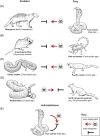
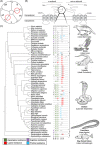


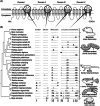
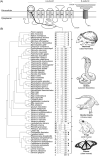

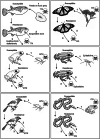
Similar articles
-
Coevolution takes the sting out of it: Evolutionary biology and mechanisms of toxin resistance in animals.Toxicon. 2017 Dec 15;140:118-131. doi: 10.1016/j.toxicon.2017.10.026. Epub 2017 Oct 27. Toxicon. 2017. PMID: 29111116 Review.
-
Hundreds of Genes Experienced Convergent Shifts in Selective Pressure in Marine Mammals.Mol Biol Evol. 2016 Sep;33(9):2182-92. doi: 10.1093/molbev/msw112. Epub 2016 Jun 21. Mol Biol Evol. 2016. PMID: 27329977 Free PMC article.
-
Convergent Evolution of Tetrodotoxin-Resistant Sodium Channels in Predators and Prey.Curr Top Membr. 2016;78:87-113. doi: 10.1016/bs.ctm.2016.07.006. Epub 2016 Aug 9. Curr Top Membr. 2016. PMID: 27586282 Review.
-
Quantification provides a conceptual basis for convergent evolution.Biol Rev Camb Philos Soc. 2017 May;92(2):815-829. doi: 10.1111/brv.12257. Epub 2016 Mar 1. Biol Rev Camb Philos Soc. 2017. PMID: 26932796 Free PMC article. Review.
-
Coevolution with toxic prey produces functional trade-offs in sodium channels of predatory snakes.bioRxiv [Preprint]. 2023 Dec 8:2023.12.08.570760. doi: 10.1101/2023.12.08.570760. bioRxiv. 2023. PMID: 38106015 Free PMC article. Preprint.
Cited by
-
Parasitic fish embryos do a "front-flip" on the yolk to resist expulsion from the host.Proc Natl Acad Sci U S A. 2024 Feb 27;121(9):e2310082121. doi: 10.1073/pnas.2310082121. Epub 2024 Feb 20. Proc Natl Acad Sci U S A. 2024. PMID: 38377205 Free PMC article.
-
Sodium Channel β Subunits-An Additional Element in Animal Tetrodotoxin Resistance?Int J Mol Sci. 2024 Jan 25;25(3):1478. doi: 10.3390/ijms25031478. Int J Mol Sci. 2024. PMID: 38338757 Free PMC article.
-
Female-female aggression in the Gila monster (Heloderma suspectum).R Soc Open Sci. 2023 May 10;10(5):221466. doi: 10.1098/rsos.221466. eCollection 2023 May. R Soc Open Sci. 2023. PMID: 37181791 Free PMC article.
-
A skin secretion metabolome analysis of the Greek Dodecanese Lycian salamanders: Preliminary evidence of dietary alkaloid sequestration in urodeles.PLoS One. 2024 Aug 29;19(8):e0300278. doi: 10.1371/journal.pone.0300278. eCollection 2024. PLoS One. 2024. PMID: 39208286 Free PMC article.
-
Neurotoxin-Derived Optical Probes for Elucidating Molecular and Developmental Biology of Neurons and Synaptic Connections : Toxin-Derived Optical Probes for Neuroimaging.Mol Imaging Biol. 2024 Dec;26(6):912-925. doi: 10.1007/s11307-024-01954-6. Epub 2024 Sep 30. Mol Imaging Biol. 2024. PMID: 39348040 Free PMC article. Review.
References
-
- Abderemane‐Ali, F. , Rossen, N. D. , Kobiela, M. E. , Craig, R. A. II , Garrison, C. E. , Chen, Z. , Colleran, C. M. , O'Connell, L. A. , Du Bois, J. , Dumbacher, J. P. & Minor, D. L. Jr. (2021). Evidence that toxin resistance in poison birds and frogs is not rooted in sodium channel mutations and may rely on “toxin sponge” proteins. Journal of General Physiology 153, 1–20. - PMC - PubMed
-
- Albuquerque, E. X. , Daly, J. W. & Witkop, B. (1971). Batrachotoxin: chemistry and pharmacology. Science 172, 995–1002. - PubMed
-
- Alexander, G. J. & Maritz, B. (2010). Bitis arietans arietans: partial resistance to Naja venom. African Herp News 50, 34–36.
-
- Almeida‐Santos, S. M. , Antoniazzi, M. M. , Sant'Anna, O. A. & Jared, C. (2000). Predation by the opossum Didelphis marsupialis on the rattlesnake Crotalus durissus . Current Herpetology 19, 1–9.
-
- Aráoz, R. , Molgó, J. & Tandeau de Marsac, N. (2010). Neurotoxic cyanobacterial toxins. Toxicon 56, 813–828. - PubMed
Publication types
MeSH terms
LinkOut - more resources
Full Text Sources
Research Materials

